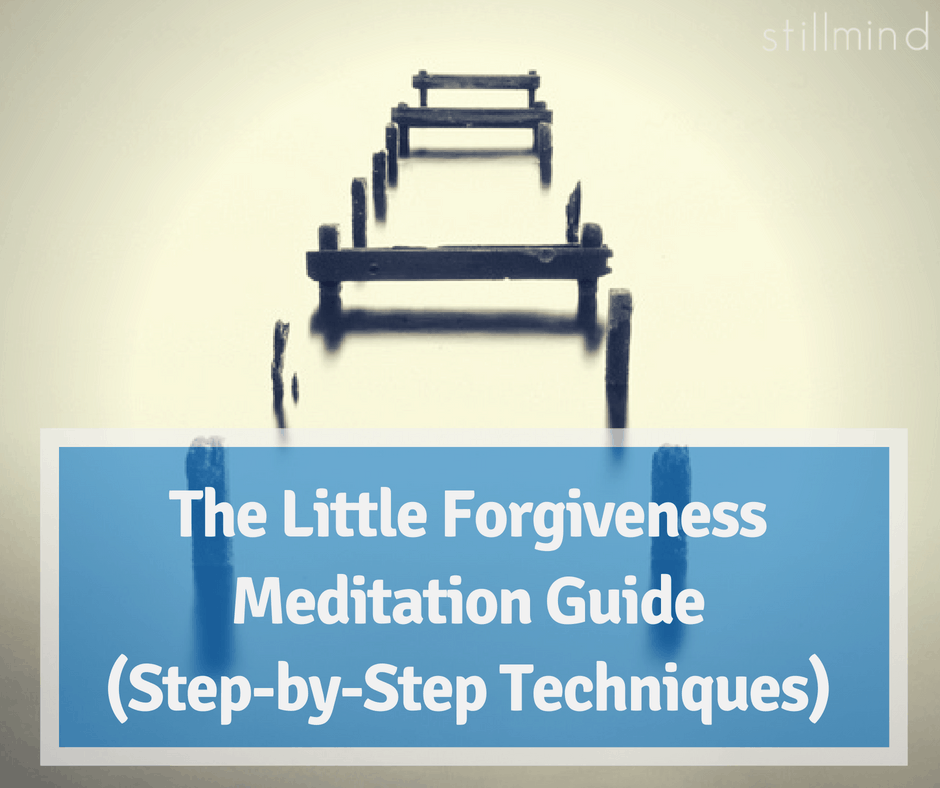
“Forgiveness is the giving, and so the receiving, of life.” ~ George MacDonald
“You hold in your hand an invitation: to remember the transforming power of forgiveness and loving kindness. To remember that no matter where you are and what you face, within your heart peace is possible.” ~ Jack Kornfield
Developing a capacity for forgiveness is a fundamental facet of the journey of learning to meditate, an important part of the process of spiritual maturation.
It is through forgiving that we loosen our burdens.
We can then enter our practice with a lightness of heart. This will do more to move us deeply into rest than any mantra or breathing exercise.
What is Forgiveness? Why Bother?
It is done in spite of the possibility of circumstances changing, that person rectifying their behavior or you getting even.
It involves a change in the way you see them. One way is through the veneer of anger and all the suffering to yourself that causes.
The second is as another human being, incessantly (perhaps mistakenly) doing what they believe will bring them happiness, and as somebody to whom you can harbor feelings of peace and love.
When it comes down to it, the only person that is suffering is you. Forgiveness involves a certain acceptance that we are responsible for how we feel. Not other people.
This is true power. Perhaps the only power which we are capable of possessing.
Try forgiveness meditation as outlined below, see how you feel.
A quick note: you may feel slightly disingenuous as you start doing forgiveness meditation, that you’re not really forgiving. Keep in mind the mantra: “As best I can.” With time, the feeling of true forgiveness will grow.
Guided Forgiveness Meditations (Release Guilt)
Forgiveness Meditation: Variation One
This is an utterly simple practice. Once you’ve read the instructions here you can use it whenever you need it.
You can also direct it towards yourself if you feel that self-forgiveness is more in order.
- Settle yourself and take a few calming breaths.
- Visualize a person who has harmed you, knowingly or unknowingly. If it is too painful to do this, choose a word or image that symbolizes them.
- Label the feelings that arise in reaction to thinking about this person. Shame, anger, hopelessness – just gently call them by their name.
- Also bring awareness to your physical sensations inside you, especially in your neck and abdomen. Are you tense or anxious?
- Keeping this person in mind, say, “As best I can, I forgive you. I wish you joy and love.” Repeat this several times.
- Finally, feel the burden of resentment lifting from you. Experience the lightness inside you. You have relinquished the hold that this person’s action had over you.
Forgiveness Meditation: Variation Two
- Settle yourself and take a few calming breaths.
- Picture a person whom you dislike or hold resentment towards. Somebody who has offended or hurt you.
- Visualize this person in your mind’s eye.
- As you look at them, perceive a white light in them. A small gleam.
- Let this light grow and encompass their whole body.
- Observe for a while this image of your enemy glowing with light.
- Now observe a close friend. Let the light to encompass them too.
- Finally, allow both your friend and enemy to offer you the light. Feel it blossom inside yourself.
Jack Kornfield (Acclaimed Author and Teacher): Forgiveness Meditation
Guided Forgiveness Meditation Exercise
Quite often those past experiences of ours that were less than positive can appear to be overwhelming, and in the present can create an experience that is less than balanced.
This healing meditation has been designed to enable you to directly access the energetic component from all of your past experiences and allow you to not only benefit from forgiveness but also provide you with the chance to let go of your past.
I strongly recommend that you only work on one experience at once. If there are numerous experiences that you are working on with a specific person I suggest that you work on just one experience at once.
Before beginning, please read through the entire meditation several times. If you feel uncomfortable at any point during this meditation, stop and do not continue with it.
It is very important before you begin to find a comfortable and quiet place where you can sit and not be disturbed by anyone for 45 minutes or longer.
Before I start, I find it useful to take a nice hot shower (but not a bath). I also like to wear comfortable, loose-fitting clothing.
The best thing to do is wait three or four hours after eating before you start. I have found that the best time to do this meditation is in the early evening.
Once you finish it, you are going to need plenty of rest. You might want to skip dinner completely and (if possible) have soup ready for you to eat after you are done meditating.
It is essential that once you finish that you give yourself 2 to 4 hours of good rest. You will have exerted a lot of energy, and your body will be very tired.
Also, although you will have made a great deal of progress in your healing process, the rest allows you to avoid revisiting the problem for several hours.
Once you wake up, you will notice a significant clearing of energy related to the specific issue.
Moving Toward Gratitude and Letting Go
When these steps are followed you will release all or most of the energy that you had related to the issue. You can always return to your experience.
However, you will have gained the experience to be able to see it in an entirely new light. Once your issue is resolved I do strongly recommend that you simply let it go. View it as a learning experience and then move forward with gratitude.
Non-Judgment
The process isn’t about blaming or judging others. It is a very powerful meditation with real energies at work.
Blaming or judging others during the meditation will prolong your healing process and also make it a lot harder to release those energies later on.
The Forgiveness Process: Step-By-Step
1. Choose an Issue. While you are sitting in your meditation space choose an issue that requires forgiveness.
It is best to select something simple until you become more familiar with this process. For a majority of people, the issue usually chooses itself the first time.
2. Relax. If you use a standard practice for starting your meditation, it will help get you in an open and relaxed place that can be used to help get you started.
3. Breathe. Focus on your breathing. Without trying to control your breath, follow your breathing (in and out ). Do it for 8-10 repetitions.
4. Introduce Affirmations. The next thing you will do is a series of affirmations while controlling your breathing. It is essential that you focus on the energy that is associated with the affirmations while you are breathing.
On each affirmation, the first part is the same. The words are repeated on the ‘in’ breath. Each one of the affirmations has a different second part, and that is repeated on the out breath.
There are three affirmations in total, and they are done in order with the order being repeated every time. The affirmations are repeated in the order of 1,2, and 3 and then you start once again at 1. The affirmations should be done for around 15 minutes.
I Am (in breath)
Whole and Complete (out breath)
I Am (in breath)
As God created me (out breath)
I Am (in breath)
Completely Safe (out breath)
5. Focus on the Issue. Focus on your experience that you selected in the beginning. It’s important to remember that you are completely in control.
Start by replaying this experience in your mind. Make sure that you focus in a very objective and clear way on those conversation(s) that you had and what the two of you said as best as you can remember.
6. Apology Exercise. Once you have finished replaying your part of the conversation. You will most likely see places where you were rude or mistreated the other individual, or went on an utterly relentless attack.
This is where you will want to offer a sincere apology and ask them to forgive you. Prepare your apology to them and then imagine putting it inside of a package that is beautifully wrapped.
Take the package and in your mind put it right in front of the individual. Bow three times and tell the person I am sorry with each bow.
Then leave (in your mind). Remember that you aren’t worried about what they do with the package or what happens to it. Your focus needs to be on making a no strings attached sincere apology.
7. Return to Affirmations and Breathing. Take a couple of minutes and repeat the affirmations and breathe for 1-2 minutes. This is to recompose and not lose momentum before going on to the next step.
8. Listen. Next replay their part of the conversation. Be quiet this time. Try to forget your original reaction.
Sometimes it helps seeing yourself as a neutral third party who is taking notes of the conversation. Be sure that you listen to what the person is saying. Then replay it once again.
Focus on what point the person was trying to make. Think about what you would say to convey this point. Once they are finished talking, thank them as sincerely as you can for sharing.
Then ask the person if there is anything else they want to tell you. Quite often you will gain a lot of insight at this point in your relationship(s). So, listen very carefully.
9. Review Without Judgment. The next thing to do is imagine the whole conservation in its entirety. Let the conversation go in whatever energetic form appears to be appropriate.
Keep in mind that you aren’t being attacked but only listening without any judgment as to what they express.
10. Be at Peace. As you are searching for the energetic package, start watching your breathing and then repeat the affirmations.
Once you are ready, then you need to let this package enter entirely into your heart. Keep breathing and repeat the affirmations. Soon you will be experiencing a deep feeling of peace.
Once you do then look into the person’s eyes and say to them:
I have received your beautiful gift completely. Thank you. I am very grateful for the gift you have given me, but I don’t need it any longer.
11. Receive Light and Love. Look deep inside your heart, and then repeat the affirmations. Let the energy you have received be transformed into pure light and love. Then repeat the following words:
I have transformed the gift you have given me into pure love. I am joyfully returning it to you full of joy and love.
12. Heart-to-Heart Connection. Next, imagine the gift of love flowing into their heart from yours. Once the transfer is done say this:
I am very honored to share this learning experience with you. May everyone be blessed with the love that we have shared with each other today.
13. Be Grateful. Say thank you to them once again and then go back to your heart center. Start the affirmations again and focus on your breathing. Do that for around 3 minutes.
Bring yourself out of the meditation slowly. Stand up, and then bow one time when you are ready. Thank the universe for giving you this healing opportunity.
References & Further Reading
https://greatergood.berkeley.edu/topic/forgiveness/definition
